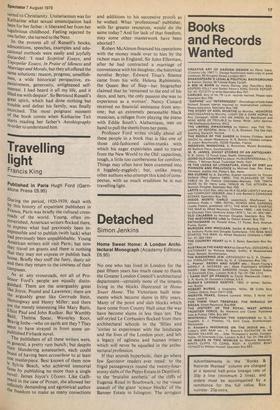Detached
Simon Jenkins
Home Sweet Home: A London Architectural Monograph (Academy Editions £6.95) No one who has lived in London for the past fifteen years has much cause to thank the Greater London Council's architectural department—certainly none of the tenants living in the blocks illustrated in Home Sweet Home. The Victorians built tenements which became slums in fifty years. Many of the point and slab blocks which have come from County Hall since the war have become slums in less than ten. The self-styled Le Corbusiers flocked from their architectural schools in the 'fifties and 'sixties to experiment with the landscape and the lives of the London poor, and left a legacy of ugliness and human misery which will never be equalled in the archetectural profession.
If that sounds hyperbolic, then go where few Spectator readers ever tread: to the frigid passageways round the twenty-fourstorey slabs of the Pepys Estate in Deptford; to the 'brutalist aesthetic' of the cliffs of Eugenia Road in Southwark; to the visual assault of the giant 'scissor blocks' of the Banner Estate in Islington. The arrogant
detachment of the men who designed these buildings—men living for the most part in friendly Victorian terraces—stands out continually in this book. 'The drawbacks of these tall blocks rapidly became selfevident once these buildings were in use,' is their bland conclusion. It was self-evident to many of us before, but the architects did not listen because tall blocks were a sign of professional virility.
However, the high-rise saga is only part of this book, which traces the much longer story of the rise and fall—and first hints of a rebirth—in the mostly noble tradition of public housing in London. The photographs are much better than the text, which is drab and self-righteous. But everything is there: the first splendid LCC buildings, still gracing Millbank just behind the Tate Gallery; the homely suburban estates, down-market replicas of Hampstead Garden Suburb; the less happy 'thirties tenements, looking oddly Germanic; the 'errors' of the post-war years—as even Kenneth Campbell, former housing architect to the LCC/GLC puts it.
And the book ends with a note of real hope. The nightmare of high-rise is now over, and public housing is reverting to a more humble and sensitive respect for the traditional qualities of London street architecture. It is a sobering irony that the last estate illustrated here, at Swinbrook Road in North Kensington, is in layout a carbon copy of the previous Victorian street pattern.
It is also one of the first estates where the architects actually discussed closely with residents what sort of housing they really wanted.



























 Previous page
Previous page